Sinner vs Alcaraz: Roland Garros Final
great fighters — the Swiss Army — running forehands and aggressive defense — backhand setups
Roland Garros 2025 was the first grand slam final in the budding rivalry between Jannik Sinner and Carlos Alcaraz. It may never be surpassed.
Alcaraz emerged the victor, coming back from two sets to love down 4/6 6/7 6/4 7/6 7/6 after five hours and 29 minutes, saving three match points from 0/40 in the fourth set.1
“What an incredible Roland Garros final!” — Rafael Nadal
“Three winners in Paris today: Carlos Alcaraz, Jannik Sinner, and the beautiful game of tennis. What a match!” — Roger Federer
“Easily one of the greatest matches of all time. Anyone who doesn’t think so is living in their own nostalgia.” — Andy Roddick
“I’ve been doing this 30 years, been lucky enough to do this. That’s one of the all-timers. Easily.” — John McEnroe
“Insane level.” — Stan Wawrinka
“The level of this whole match was insanity!” — Alex de Minaur
“Is this the greatest tennis match ever?” — Mardy Fish
Wimbledon 1980. Wimbledon 2008. Australian Open 2012. Wimbledon 2019.
Roland Garros 2025 is on that list as the flag bearer of Nextgen tennis.
“Honestly, if people put our match in that table, it’s a huge honour for me. I don’t know if it’s at the same level as those matches because those matches are, you know, the history of tennis and the history of the sport. So I let the people talk about it.”
— Carlos Alcaraz
In writing this newsletter I’ve made a habit of comparing these new greats against the Big-3. Are they better? Or has tennis simply “gone sideways in an interesting way”? My final answer is that it doesn’t matter, because what Carlos and Jannik are doing on the tennis court hasn’t been seen before. Not at this speed. Not with this variation. It’s Playstationesque. And what’s encouraging is that, even as the game has ‘optimised’ into a double-fisted baseline slugfest, the individuality of greats still bleeds onto the canvas: Sinner’s gunslingin’ forehand is somehow both metronomic and lethal off his chapless Nike hips, whereas Alcaraz’s appears to be the Swiss Army’s take on a nuclear warhead: compact, multifaceted, devastating.

The numbers back up the eye-test. Here’s a Nextgen stat:
Maybe on paper Sinner is a better tennis player: he is taller, with a better serve and a more consistent baseline strategy that spits out better numbers against the field, but Alcaraz seems to disqualify all notions of serial analysis: his game must be witnessed as flesh and blood and reckoned with all at once. For his fans, watching Carlos Alcaraz win ‘My Way’, is fucking horrifying: a sickening rollercoaster of twists and turns that — like all great thrill rides — somehow has you wanting more as soon as it’s over.
Before the final I posted some serve/return thoughts on Twitter:
To Sinner’s credit, my one sentence summary of his performance today would be: “you crushed it real good, buddy.”
With the help of his new return stance — a move designed to give the Italian more forward momentum with which to strike the ball — Sinner took all of Alcaraz’s variation and shoved it back in his face at Mach 5 off both wings for the better part of five hours. That’s why we didn’t see the three-dimensional Jazz festival from Carlos’ end — fewer slices, an unusual number of errant drop shots, flattened trajectories. It’s hard to improvise when you’re getting punched in the face.
The Ad-court kick serve was handled more aggressively and more successfully than Rome. Three times on Ad-court break points, the Sinner backhand crosscourt return registered an error from Alcaraz’s +1 backhand.2
Sinner also answered the fitness question. This match was gladiatorial all the way into the sixth hour, and while the legs shook, they didn’t falter.
“It’s the most complete examination of an athlete that I can think of.”
— Any Roddick, on modern day Grand Slam tennis
It’s impossible to do this match justice on a 12-hour turnaround. I skim through much of the match and stop in others to show you what I saw, and what I felt. Perhaps I’ll come back and tend to this piece later when I’ve had time to dig deeper and find some numbers to grasp what happened here today.
First Set
Both men fought off break points in their opening service games. Alcaraz was mixing in deep and aggressive return positions, whereas Sinner was more committed to holding the baseline and vaporising the ball through lower altitudes.
It didn’t take long for the quality to bleed into Chatrier’s clay:

While the pair was still finding the range with their forehands, their line backhands picked up the slack and were instrumental in the early games. There are no safe spaces with these two.
And on the topic of backhands, at the start of the year I was skeptical of Alcaraz’s new lowered backhand takeback.
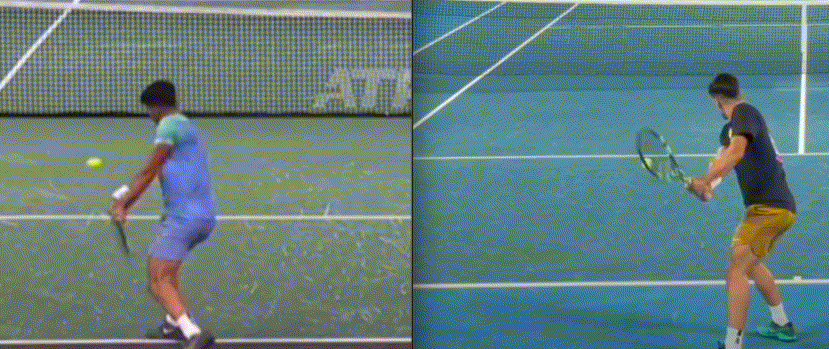
I felt this lower, straighter setup would struggle on higher balls, and when pushed wide. I must eat my words, or at least qualify them with the belief that what Alcaraz was doing here on the clay was a fusion of both techniques, depending on the context, as the slow-mo of the above winner shows:
And perhaps using a fusion is where he will stay. He is a shapeshifter after all.
But grand slam finals are won with forehands, and that was going to be the case today. Sinner found his first forehand winner when he most needed it: down another break point.

But it wasn’t enough in that game, and Alcaraz did break through, finally, on his seventh break point of the match.
The average rally length through the first five games was over 5 shots, and it was suiting Alcaraz, who would end up having the edge in this match in the 5-8 and 9+ rally length stat.
But just as quickly as Alcaraz built a lead, he lost it, with Sinner making amends from Rome, taming the Alcaraz kick serve and firing his Ad-court backhand return hard enough to draw out a backhand error. It would be the exact same way he would break later in the set to seal it.
“that heavy kicker out wide, that was a serve that Alcaraz used against Sinner at the US Open when he beat him in that five set epic. Heavy kicker out wide to set up the point, sometimes he serve-and-volleyed behind it, but it took Jannik off the court so well.”
— Robbie Koenig
Key Stat: Alcaraz missed eight second serve returns in the first six games — some of them trademark deep forehands — and that ultimately cost him the first set, as he was only able to break once, despite having multiple opportunities in the first three Sinner service games.
Second Set
Sinner made an ominous start to the second set, racing out to a 3-0 lead, thanks in part to some great backhand returns to break, and some nuclear hitting through the court. There aren’t many who can make Carlos look rushed on clay from ten feet behind the baseline.
Up to this point, Sinner was making more first serve returns in play (92% versus 84%) and had hit more winners.
But we have to fast-forward to the breaker.
Alcaraz got down 6-2, but was conjuring magic to keep his hopes alive:

And while Alcaraz had perhaps gifted some points in this breaker, the set point was simply a case of a sinner committing theft in broad daylight:
“He’s [Sinner] come up with some running forehands at the perfect time. His ability to defend so aggressively is what the modern day player does so well.”
— Robbie Koenig
THIRD SET
We’ve got to keep moving. But Carlos Alcaraz won this match:
Fourth Set
Sinner went right back to work at the start of the fourth, playing inside the lines to go straight through Alcaraz like a freight train, and Alcaraz, playing outside the lines, doing his best to go above and around the Italian:
And it’s hard to emphasise just how violent the speed was on some of these shots. Each great player makes the game an art form in their own way. Sinner has applied a kind of brutalist brush stroke to his entire game in a way that almost completely smothers Alcaraz’s tennis nouveau style. Gifs don’t convey the gasps that were coming from the crowd on some of these forehands:
In my notes I have written “Sinner nuclear forehand” at 3-3 0-30 and 4-3 0-0. It must be said again that I don’t think I’ve ever seen Sinner hit the running forehand so well for so long against such a heavy ball that Alcaraz was hitting. And it was good enough that the Italian found himself up 5-3 and returning to win the match.
It was from here, on the precipice of defeat that the first “I’m Him” moment unfolded for Alcaraz. A combination of brutal Sinner returns and poorly-timed double faults led to 0/40 triple match point. The commentators started to roll out those praising sentences of Sinner that signal that the trophy ceremony is going to start soon. But Alcaraz had other ideas, and he managed to claw back to deuce, in part, thanks to Sinner perhaps blinking on one or two shots.
Not points. Shots. Because on the 0/40 and 30/40 points, Alcaraz had to fight for territorial pressure using spin and depth with his forehand to earn the errors.
A timely ace brought him to game point, before he threaded one of the coldest forehands I’ve ever seen him hit:

Although Sinner was still serving for it at 5-4, only he knows the demons that accompanied him to the opposite baseline on that long 90-second changeover. His level certainly dropped — if just by a hair — and that was enough to let a free-swinging Alcaraz step in and ply his usual spin-craft, breaking the sidelines and using the forecourt like the all-court player he is:

“Anyone who has ever played this game at any sort of level knows that when you have had match points and you haven’t converted, you have a sinking feeling inside your chest. And it can weigh you down.”
— Robbie Koenig
Alcaraz broke back and all of a sudden a great match had the possibility of becoming legendary.
Sinner regathered at 5-6 to force another tiebreaker. The Italian got out to a fast start courtesy of two groundstroke errors from Alcaraz. The fact that Sinner kept building leads in the third and fourth sets made you think that Alcaraz was simply fighting to make the scoreline more respectable, that Sinner had been too strong, too clinical.
But again Alcaraz found more ways around the Italian (in a literal sense) on the next three points: a rifled crosscourt forehand winner, a wide ad-side kick serve ace, and then a sliding ace on deuce.
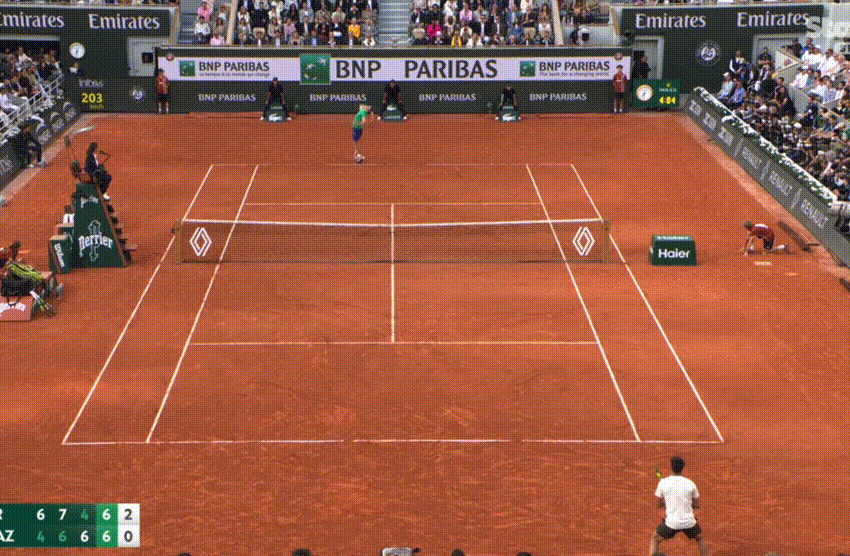
Those three points flipped the script, the animal spirits of the crowd simultaneously lifting Alcaraz’s game while suppressing Sinner’s. By 6-3 Alcaraz’s momentum made the fifth set feel inevitable:
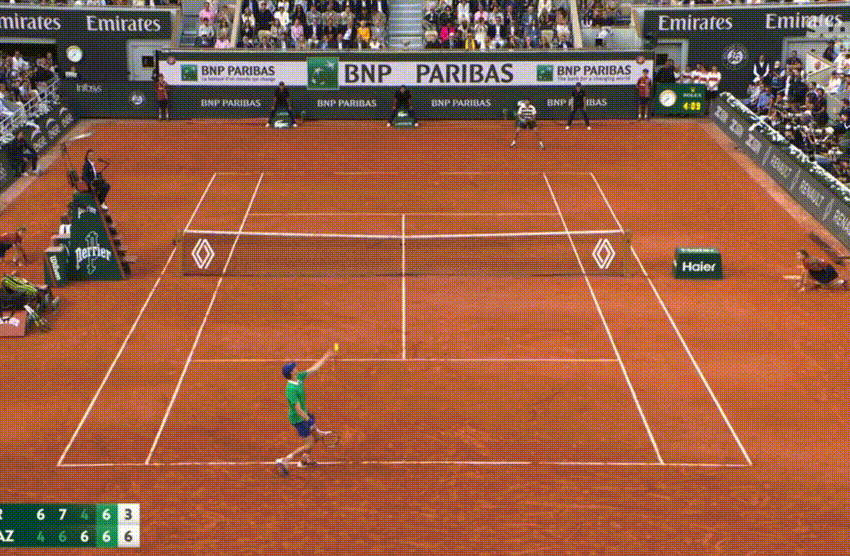
Fifth Set
In the early exchanges of the fifth I thought it was going to be a blowout. Alcaraz broke Sinner in the opening game, who’s game and body looked to be unraveling under the weight of what had transpired late in the fourth set. The linear potency was gone, and Alcaraz didn’t seem as rushed. As a result, the Alcaraz drop shot made a successful return.
At 3-2 Alcaraz opened his service account with a tumbling forehand volley drop shot:
Having survived so much adversity, and now leading with a break against a fading Sinner, the fifth set felt like a denouement.
It was now Alcaraz’s turn to serve for the match at 5-4.
He lost the first point with a rash forehand and found himself in a hole at 15-30. It was here that Alcaraz, as is his trademark, deployed the drop shot to good effect once more. Sinner was tired, behind the baseline.
I don’t know how he got there, or how he played it back so deftly, but it was perhaps the biggest cheer he got all match, the crowd ecstatic to get more of this already classic.
Well of course Sinner broke back.
If there was a word that could have described this match at every twist and turn it was ‘escalation’. Things just got wilder and wilder as it unfolded.
Sinner held for 6-5. It’s a great game in its own right (as most of them are) but we must move on. We were now well past the five hour mark and the intensity, shot-making, physicality, and nerve management hadn’t meaningfully dipped at any point in the match.
I think the hold from Alcaraz at 5-6 in the fifth is one of the great single games of tennis I’ve ever witnessed.
All-in stakes. Sinner’s return trumping Alcaraz’s serve, only for Alcaraz to somehow one-up that shot with end-range defensive magic, before someone pulled an Ace on the river, again and again, in this one pivotal game.
Two points that are seared in memory from first viewing:
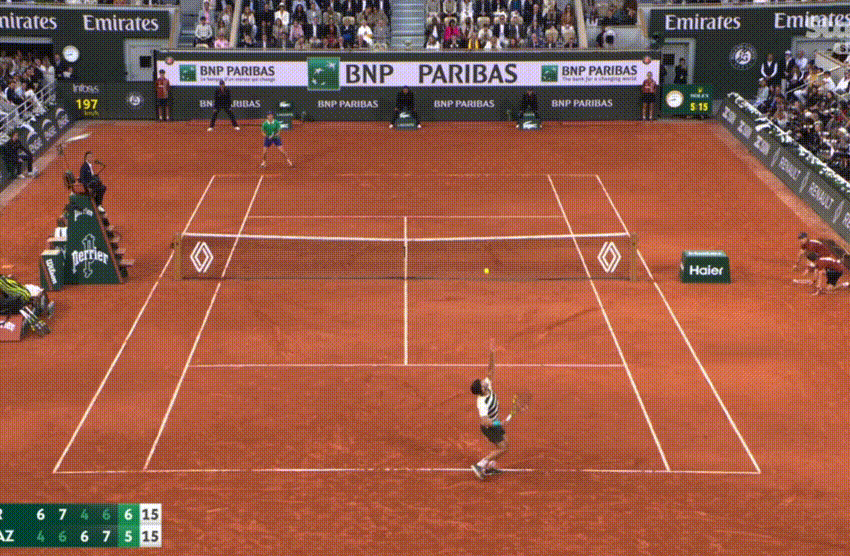
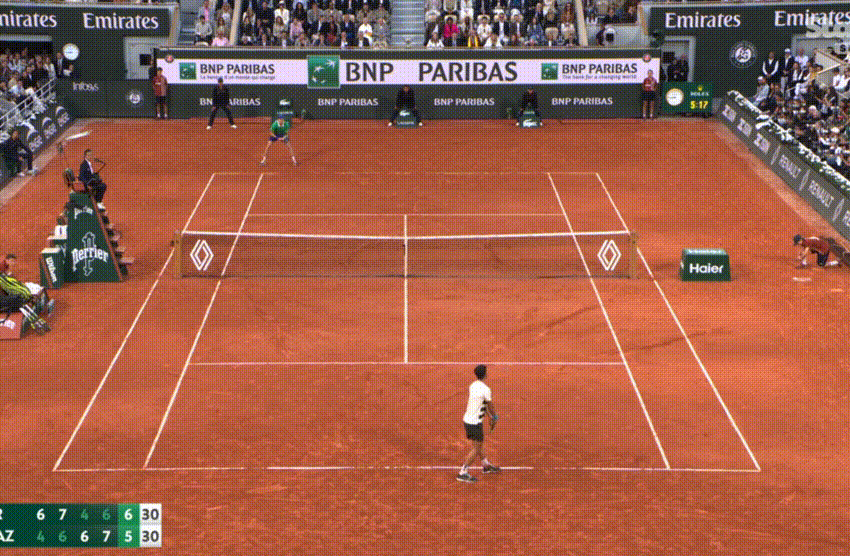
There’s a couple of other mic-drop points in that game. Truly. I just don’t have the time or mental/emotional bandwidth to address it now because there’s the final set tiebreaker still to come. I take game-by-game notes during matches right here in the substack editor, so I’ve attached as a footnote this particular game’s notes, which deviate from the usual sober analysis a touch.3
Final Set Tiebreaker
Alcaraz was unconscious for most of this tiebreaker, racing out to a 7-0 lead off the back of flawless tennis that made one question whether this whole thing — life — was a simulation. Is this really happening? How does he play like that in these moments? Once again, Sinner didn’t gift him this 7-0 lead. He fought tooth and nail, and came up empty handed because of shots like this:
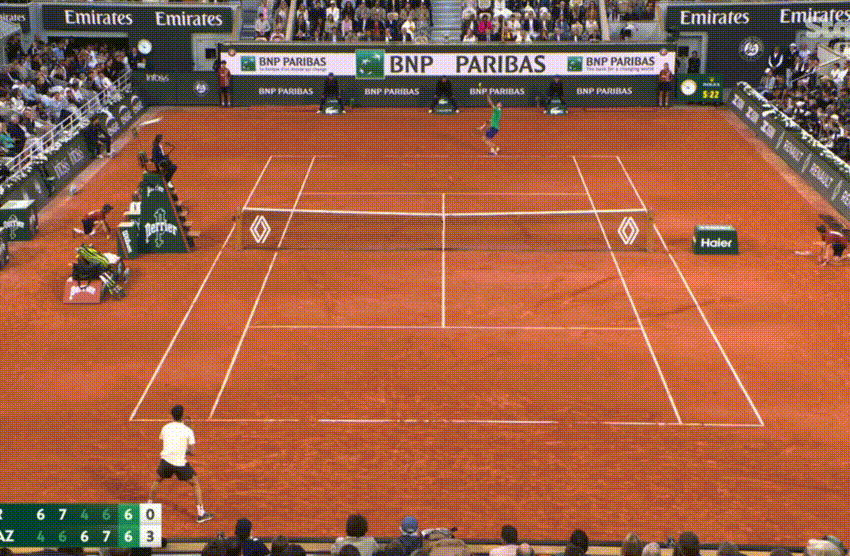
Matt Willis had more level-headed answers. Alcaraz blended patience and aggression perfectly in this buster of all busters:
It’s a delicate balancing act when you have so many options and so much power on tap, especially when Alcaraz is so uncompromising in his fate: he wants to attack, entertain, and win. All at once, on all occasions. That he manages to find the balance in the biggest moments (Wimbledon 2023, anyone?) is worthy of a case study. As I wrote after that Wimbledon triumph:
To blend excitement with winning is a talent in itself because so often their interests run counter to one another. Ali, Jordan, and Woods had that quality about them and transcended their respective sports. Kyrgios achieves the former at the expense of the latter. Alcaraz has certainly found the balance.
And as if this match needed a punctuation mark, we got one on Alcaraz’s first match point:
A quote from last year’s Roland Garros Final came to mind:
“In the fifth set of the final is the time to give it all, fight until you can’t fight anymore. That’s what makes you a warrior, and I consider myself a warrior.”
— Carlos Alcaraz
Alcaraz is now 13-1 in five setters. 5-0 in slam finals. 12-2 in big finals. Perhaps most interesting is how antithetical his style is to Djokovic’s ‘lockdown mode’ of clutch-ness, yet seemingly just as clutch.
Quotes
Alcaraz, on finding his best tennis in big moments:
“I always repeat myself. In specific moments, I have to go for it, no matter if I’m down, or if it’s the super tiebreaker in the fifth. I just thought that it’s time to go for it, not be afraid of the mistakes, and I think was all about belief in myself. I never doubted myself today, and I tried to go for it. That’s why I saw my best tennis in crucial moments.”
On the importance of entertaining the fans:
“honestly, there were a few moments of the match where the level was insane…I thought sometimes about the people, and I thought the people were enjoying a little bit as well.”
It’s a bitter loss for Sinner, but he will be made aware in the coming days, months, and years, of the role he played in this match. What’s more, you can bet that a champion of his calibre will take lessons, and motivation, and come back stronger.
While this tournament started with the send-off of an all-time great, it concludes with the birth of two more. Class players and class acts. Unflinching good sportsmanship throughout the whole affair.
How lucky we were. How lucky we still are.
That’s all I’ve got. See you in the comments, and on the grass. HC
Sinner won 193 points, Alcaraz 192.
first set 3-2 30-40 and 5-4 30-40; fourth set 3-3 0-40.
first point is RIDICULOUS (Sinner just gave a smile to Wilander)
15-0 again the Sinner backhand return doing DAMAGE, forces the error
15-15 the defensive slice into the half volley WHAT ON EARTH?!
the replay on TSN is outrageous
poetic that Sinner might have figured him out on the half volley finally
30-30 FUCK OFF CARLOS. what is that?
40-30 AGAIN that backhand line return from SINNER. If he’s winning this it may be because of that shot in stages
deuce is stupid again. This quality. Stupid.
Backhand pass from Carlos to hold OMG. This may be the greatest match of all time.
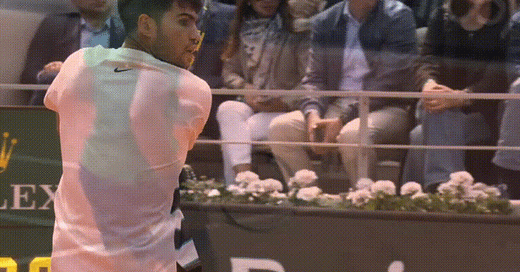


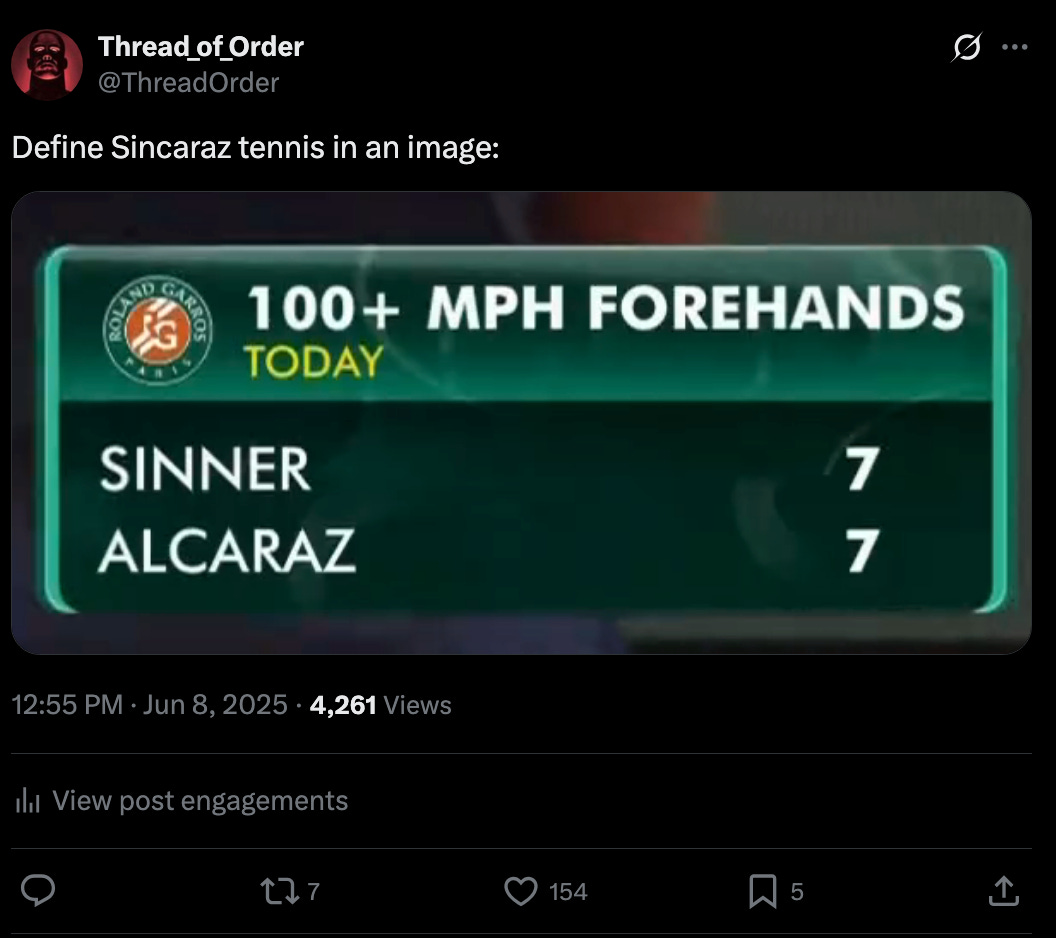










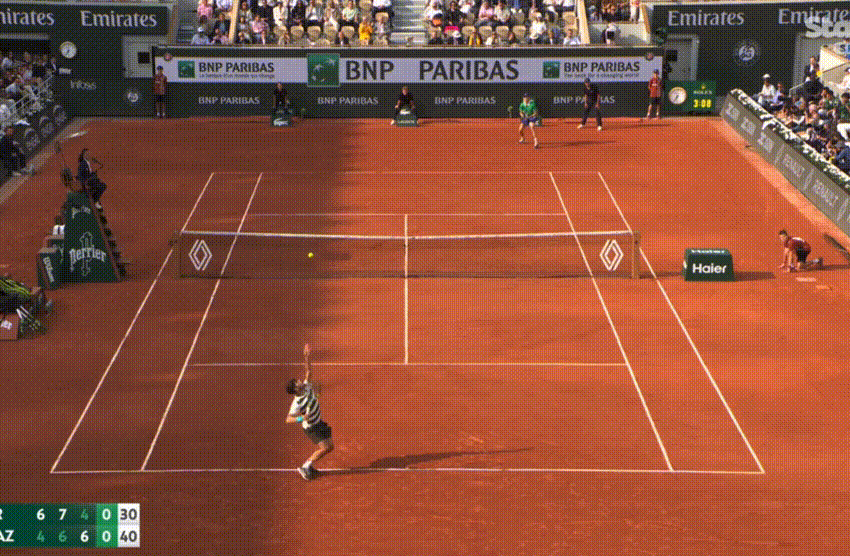





That forehand squash shot at 5-6 30-30 was insane. HOW did he get it, HOW did it get enough air that Sinner had to check and reverse, HOW did he have the certainty to hit the crosscourt backhand winner. Without that forehand, if it goes past him or he gets it and it goes out, he's matchpoint down again, and in the event Sinner crushed the return so it went back to deuce but it could have been..
The one stat that I pulled out was points won on second serve, which I think is always telling: I've always believed that you can predict the winner of a match going in by their tournament-so-far percentage won on second serve return.
The RG stats machine said it went like this:
• points total won on return: Sinner 40% (71/194), Alcaraz 39% (75/191)
• points won on return of first serve: Sinner 37% (42/113), Alcaraz 30% (31/103)
• points won on return of 2nd serve: Sinner 43% (35/81), Alcaraz 50% (44/88) - the only stat on return of serve where he's ahead.
Which I'll take as confirmation of my belief!
Was patiently waiting for your take on this match :) I'm well on the side thinking 'Sinner is the better overall player, but he has a matchup issue with Alcaraz'. For a short (well, not that short) it looked like he figured it out, but Alcaraz simply has something no one on tour has and that's the combination of almost being able to go bomb-to-bomb with Sinner for certain stretches, with an unrivaled movement and shot arsenal. It's no match for Rune (I still believe in him) at least :) Great read, as always